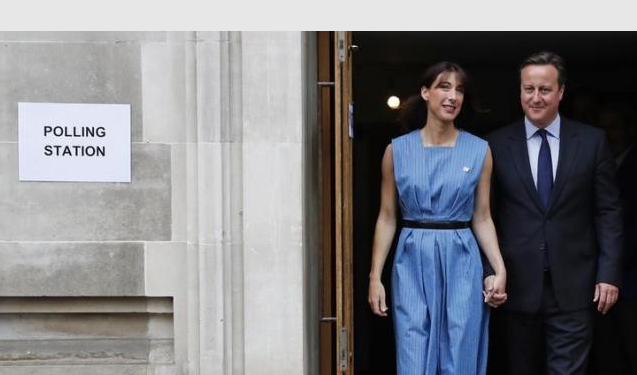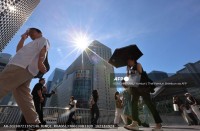
(REUTERS) Britain holds a referendum on whether to stay in the European Union on Thursday. Reuters will offer live coverage of the results throughout the night and carry UK Press Association results from each of the 382 counting areas.
Following are details of how the ballot count will work on the night. All times in GMT, an hour before local UK time.
WHEN WILL RESULTS COME?
Votes will be counted by hand, starting as soon as polls close at 2100 GMT (1700 EDT).
Each of 382 local counting areas will tally the number of ballot papers cast and announce local turnout figures (including spoiled ballots and postal votes) in each of the areas. The Electoral Commission has estimated that most turnout announcements at counting-area level will come between 2230 on June 23 and 0130 on June 24. The last turnout figure is expected at around 0400.
Each area will count the votes and announce totals for REMAIN and LEAVE. The majority of counting areas are expected to declare between around 0100 and 0300 on June 24. The last declaration is expected around 0600.
Local totals will be collated into totals for 12 regions, and then a final, national, result. The final result will be announced in Manchester by Jenny Watson, Chief Counting Officer.
WHEN CAN PEOPLE VOTE?
Polling stations open at 0600 on June 23 and close at 2100.
ARE ALL THE COUNTING AREAS THE SAME?
No. The counting areas, based along the lines of local government authorities, vary widely in population. The biggest counting areas are Birmingham, Leeds and Northern Ireland.
The Birmingham area has around 700,000 eligible voters while the City of London counting area, comprising the central financial district of the capital, has just 7,000 eligible voters. The smallest counting area is the Isles of Scilly which has about 1,700 voters.
Estimated time of declarations in the bigger areas: Northern Ireland around 0030, Birmingham around 0330, Leeds around 0400, Glasgow around 0400, Sheffield around 0330, Cornwall around 0230-0300, Bradford around 0200, Durham around 0130, Manchester around 0400 and Edinburgh around 0300-0400).
London’s counting areas are along the lines of the city’s 32 boroughs.
WHAT TO WATCH FOR
1) Turnout could be key to the result but only partial figures will be available initially. Turnout at last year’s British parliamentary election was 66 percent. Turnout well below this is likely to favor Leave as those who back Brexit are considered more likely to vote, according to campaigners on both sides.
2) First results: Sunderland, likely to be one of the first results to declare (2330), has a large number of older, lower income voters who polls show are more likely to back Brexit. If Leave are not strongly ahead here it may indicate they will struggle to break through in areas less favorable to Brexit.
3) Geography: Leave is expected to do well in eastern England, so close results in some of the most euroskeptic areas such as Southend-on-Sea (0200) and Castle Point (0130) could give an indication the national vote has swung towards Remain.
4) Labour voters: Opposition Labour Party supporters are considered key to securing a Remain vote so the results of traditional Labour strongholds such as the north of England and south Wales, where backing for the anti-EU UK Independence Party has risen, will be closely watched.
Early declarations in such areas include Oldham (0000) and Salford (0030) in northern England and Merthyr Tydfil (0030) in Wales.
5) Scotland: Scotland is considered to be pro-EU, so any close early results from Scotland such as Stirling (0030) could indicate trouble for the Remain camp.
6) Swing seats: Nuneaton (0100) is considered a bellwether seat in parliamentary elections so will be watched to see if Prime Minister David Cameron has managed to get swing voters who last year backed his Conservatives to turn out for Remain.
7) Count chronology: Some research has indicated Remain could be well ahead at first and that from around 0300-0400 the Brexit count is less likely to deviate from the end results. Others, as the Open Europe think tank, have suggested that by about 0330 most of strongest Leave areas will have declared so if Leave do not hold the lead or even if it is very close, it may bode badly for them. Ron Johnston, a professor of geography at the University of Bristol who has researched the counting areas and modeled how the vote could unfold, said the big picture was that the figures could flip around until about 0300.
WILL THERE BE AN EXIT POLL?
There are no plans by broadcasters for an exit poll as the margin of error is deemed too large, but there have been reports that some hedge funds may have commissioned private polls which could affect markets.
Details of a telephone poll conducted before the voting by Ipsos MORI for the Evening Standard newspaper are expected to be published during the day. The findings of a YouGov poll, based on interviews conducted online on Thursday, are due to be announced by Sky News after the close of voting at 2100.
THE QUESTION
Voters will be given one piece of paper with the question:
“Should the United Kingdom remain a member of the European Union or leave the European Union?”
They will be asked to put a cross beside either:
“Remain a member of the European Union”
“Leave the European Union”
WHO CAN VOTE?
The electoral commission says 46.5 million people can vote, including all those who are entitled to vote in a UK parliamentary election. Voters include British citizens 18 and older who are resident in Britain, and those who live abroad if they have appeared on a parliamentary voter register in the last 15 years.
Citizens of Ireland and countries of the Commonwealth of mostly former British colonies can also vote if they live in Britain, but citizens of other EU countries who live in Britain cannot. Voting will also take place in Gibraltar, the British overseas territory on the coast of Spain.
REGISTERING TO VOTE
Britain extended the voter registration period for the referendum to midnight on June 9 after a late surge in applications crashed a website shortly before the original June 7 midnight deadline.
CAN THE COUNT AND VOTE BE CHALLENGED?
This is unlikely. The electoral commission says the rules do not provide for a national recount under any circumstances. Requests for local recounts can be made at the local level, to be decided by the counting officer.
“We expect local recounts to be granted if a specific issue has been identified with the process in that counting area, rather than simply when the local totals are close,” the commission says.
The only way to challenge the national referendum result is by judicial review, which must be requested within six weeks of the certification of the result.
Sources: Electoral Commission, Open Europe, Reuters reporting







